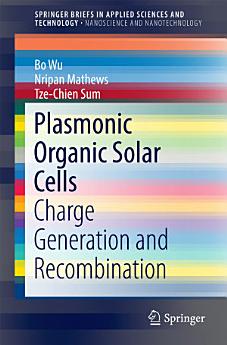Plasmonic Organic Solar Cells: Charge Generation and Recombination
Bo Wu · Nripan Mathews · Tze-Chien Sum
Oct 2016 · Springer
Ebook
106
Pages
reportRatings and reviews aren’t verified Learn More
About this ebook
This book explores the incorporation of plasmonic nanostructures into organic solar cells, which offers an attractive light trapping and absorption approach to enhance power conversion efficiencies. The authors review the latest advances in the field and discuss the characterization of these hybrid devices using a combination of optical and electrical probes.
Transient optical spectroscopies such as transient absorption and transient photoluminescence spectroscopy offer powerful tools for observing charge carrier dynamics in plasmonic organic solar cells. In conjunction with device electrical characterizations, they provide unambiguous proof of the effect of the plasmonic nanostructures on the solar cells’ performance.
However, there have been a number of controversies over the effects of such integration – where both enhanced and decreased performance have been reported. Importantly, the new insights into the photophysics and charge dynamics of plasmonic organic solar cells that these spectroscopy methods yield could be used to resolve these controversies and provide clear guidelines for device design and fabrication.
Transient optical spectroscopies such as transient absorption and transient photoluminescence spectroscopy offer powerful tools for observing charge carrier dynamics in plasmonic organic solar cells. In conjunction with device electrical characterizations, they provide unambiguous proof of the effect of the plasmonic nanostructures on the solar cells’ performance.
However, there have been a number of controversies over the effects of such integration – where both enhanced and decreased performance have been reported. Importantly, the new insights into the photophysics and charge dynamics of plasmonic organic solar cells that these spectroscopy methods yield could be used to resolve these controversies and provide clear guidelines for device design and fabrication.
About the author
Dr. Tze-Chien Sum is an Assistant Professor at the School of Physical and Mathematical Sciences (SPMS), Nanyang Technological University (NTU), where he leads the Femtosecond Dynamics Laboratory. He received his Ph.D. in 2005 from the National University of Singapore, where he worked on the development of proton beam writing for photonic applications. Upon joining the NTU as a Lecturer in 2005, he switched to the more exciting field of femtosecond time-resolved spectroscopy and established the xC-Lab research group – a lab for the investigation of exCited-state phenomena. His research focuses on investigating light-matter interactions, energy and charge transfer mechanisms, and probing carrier and quasi-particle dynamics in a broad range of emergent nanoscale and light harvesting systems.
Dr. Nripan Mathews is an Assistant Professor at the School of Materials Engineering, Nanyang Technological University (NTU). He pursued his PhD at a joint Commissariat à l’énergie atomique (CEA) – Centre national de la recherche scientifique (CNRS) – Université Pierre et Marie Curie (Paris VI University) laboratory, where he studied the signatures of optical excitations within molecular crystals (2008). He was also a visiting researcher at Prof. Michael Graetzel’s laboratory at École Polytechnique Fédérale de Lausanne (EPFL), where he participated in a pan-European project on photoelectrochemical hydrogen production. His research focuses on a wide variety of novel materials (metal oxides, organic semiconductors, graphene, carbon nanotubes, sulfides, selenides) and novel morphologies (one-dimensional structures such as nanowires and nanotubes, thin films, and two-dimensional nanosheets) produced by a range of fabrication techniques. He has primarily investigated the electronic and optical properties of these materials and how they can be adapted for practical applications
Dr. Nripan Mathews is an Assistant Professor at the School of Materials Engineering, Nanyang Technological University (NTU). He pursued his PhD at a joint Commissariat à l’énergie atomique (CEA) – Centre national de la recherche scientifique (CNRS) – Université Pierre et Marie Curie (Paris VI University) laboratory, where he studied the signatures of optical excitations within molecular crystals (2008). He was also a visiting researcher at Prof. Michael Graetzel’s laboratory at École Polytechnique Fédérale de Lausanne (EPFL), where he participated in a pan-European project on photoelectrochemical hydrogen production. His research focuses on a wide variety of novel materials (metal oxides, organic semiconductors, graphene, carbon nanotubes, sulfides, selenides) and novel morphologies (one-dimensional structures such as nanowires and nanotubes, thin films, and two-dimensional nanosheets) produced by a range of fabrication techniques. He has primarily investigated the electronic and optical properties of these materials and how they can be adapted for practical applications
Rate this ebook
Tell us what you think.
Reading information
Smartphones and tablets
Install the Google Play Books app for Android and iPad/iPhone. It syncs automatically with your account and allows you to read online or offline wherever you are.
Laptops and computers
You can listen to audiobooks purchased on Google Play using your computer's web browser.
eReaders and other devices
To read on e-ink devices like Kobo eReaders, you'll need to download a file and transfer it to your device. Follow the detailed Help Center instructions to transfer the files to supported eReaders.





